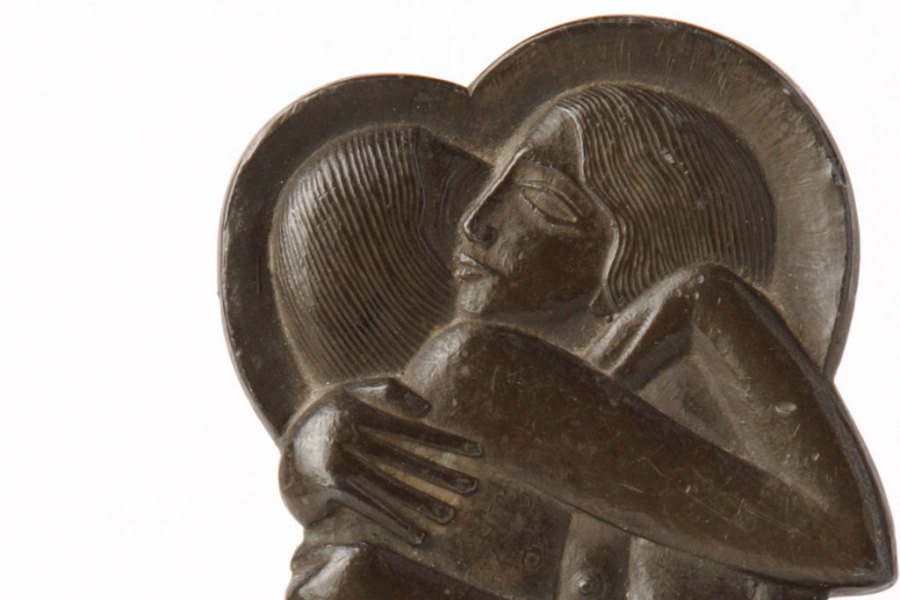The ‘modernism’ of ‘Sussex Modernism’, the sixth exhibition hosted by Two Temple Place in London, is pretty broad. It is thoroughly interdisciplinary, including painting, film, sculpture, literature, furniture, architecture, music and photography. Stylistically, it covers a fair few of modernism’s subcategories: post-Impressionism, surrealism, symbolism, romanticism, and a spectrum of abstractions. Sussex-made, these works are not exclusively ‘about’ Sussex. As well as the countryside and coast, the works here are inspired by religion, iconography, classical mythology, a dancer’s footprints and Mae West’s lips.
Mae West lips sofa (1938), Edward James/Salvador Dali © Salvador Dalí, Fundació Gala-Salvador Dalí, DACS 2017 and with kind permission from West Dean College – The Edward James Foundation. Image courtesy of Royal Pavilion & Museums, Brighton & Hove
In the early 20th century, Sussex emerged as a site of retreat – from the nearby city, from capitalism, from industrialism, and war. Vanessa Bell and Duncan Grant left Bloomsbury to set up home at Charleston in Lewes. Eric Gill and David Jones helped establish a Catholic arts and crafts community in Ditchling. Edward James (an eccentric aristocrat) populated his West Sussex mansion, West Dean House, with surrealist art and artists. Hitler’s rise to power in Germany caused a number of émigré painters, architects, and filmmakers to come to the Sussex coast (where, Edward Wadsworth noted from his Maresfield home, the guns of war could be heard). Socialist-minded modernists like Serge Chermayeff, Moholy-Nagy, Eric Ravilious and John Piper joined Peggy Angus at her shepherd’s cottage (‘Furlongs’) on the South Downs. The exhibition features all of these Sussex sites and artists, and many more.
If you’re familiar with the recent critical push (spearheaded by Alexandra Harris in Romantic Moderns) to recognise the romantic strains and bucolic celebration in modernism, you may expect ‘Sussex Modernism’ to be a gentle, rolling-hilled continuation of that. But it isn’t. The anxieties and contradictions that have always peppered modernism still pervade here.
The first work you encounter at Two Temple Place is a marble coffer carved with a relief of a languid, eroticised nude by French sculptor Henri Gaudier-Brzeska. This is the first of many works in the show that were made as gifts between the members of Sussex’s avant-garde circles. Ceremoniously presented to the writer Wilfrid Scawen Blunt in his grand and secluded country home in Petworth, the coffer contained poems penned by Ezra Pound and some of his acolytes. Pound admired Blunt as ‘the last of the great Victorians’, and in this somewhat ‘anti-modern’ gesture we get a sense of the underlying concern of the exhibition: whether the relocation of these ostensibly modernist artists to Sussex was a retreat or a rebellion. The ‘last great Victorian’, it so happens, was not a fan of his modernist present. Blunt in nature as in name, he wrote the poems off as ‘word puzzles’ and turned the nude to face the wall.
It is tempting to read the implicit Victorian/modernist clash of this first work as nothing more than a cheeky nod to the incongruity of housing a modernist exhibition in William Waldorf Astor’s neo-gothic, ornate late Victorian mansion. But exhibition curator Hope Wolf offers subtle and convincing readings of the incongruous elements that jostle in-and-between these works, to reveal a modernism that turns on the yoking together of opposites.
Like Pound, the Guild of St Joseph and St Dominic – founded in Ditchling in 1920 by Eric Gill and others – simultaneously celebrated the past while reinventing it for the present. Members of this Catholic community understood their move to Ditchling as a rejection of the industrialism that robbed artists and craftsmen of their identity, and as a condemnation of a culture that worshipped money over God. The works they produced drew on religious, classical, and pastoral themes whilst breaking – sometimes dramatically – with artistic convention. Eric Gill’s eroticised figures disturbed various contemporaries and compatriots and are, for many, even more disturbing today in light of Fiona MacCarthy’s biography, which revealed the artist’s incestuous abuse of his daughters (who were often also his models). Gill’s Garden Statue (The Virgin), with its sexually charged depiction of ecstasy, is an arresting sight near the exhibition entrance (you’d be forgiven for not first turning to Gaudier-Brzeska’s box). Once a feature in Roger Fry’s garden, this version of the Virgin replaced Gill’s first response to Fry’s commission. Mulier (1911) – a ‘nipple-pinching Blessed Virgin Mary’, as Wolf puts it – was deemed by Fry to be too provocative for visitors, and was rejected.
It is difficult not to say more about the experience of visiting Two Temple Place itself and, slightly sadly, the final room of the exhibition demands it. This grandiose space, with its painted (not stained) east- and west-facing windows and gilt, wood carved figurines, overwhelms many of the works. Not, though, the large mural preps created by Bloomsbury atheists for Berwick church, which are glorious.
Two Temple Place was acquired by the Bulldog Trust in 1999, and one of the key aims of its winter exhibition programme is to promote regional museums and galleries. It has more than done its job here. Nine Sussex-based institutions partnered with the Trust for this exhibition: they range from traditional galleries (the Jerwood, Pallant House, Towner) and museums (Brighton Museum, the Ditchling), to the modernist De La Warr Pavilion, and three properties that housed various of the artists and patrons featured in the exhibition – West Dean College, Farleys House and Charleston.
In her accompanying catalogue essay, Hope Wolf quotes from Virginia Woolf’s Between the Acts: ‘Dispersed are we; who have come together’. The kaleidoscopic vision that characterises much of Woolf’s writing is an apt introduction to ‘Sussex Modernisms’. The practices, ideas, and works featured here are certainly diverse, but there are biographical and conceptual links to be made, and these are made well.
‘Sussex Modernism: Retreat and Rebellion’ is at Two Temple Place, London, until 23 April.
